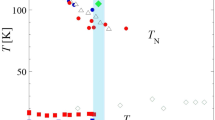Abstract
A model of simultaneous magnetic and structural first-order transitions in crystals with strong cubic magnetic anisotropy has been constructed on the basis of a combination of the magnetic modified 8-state Potts model [1] and theoretical models of structural phase transitions in cubic crystals [2]. The magnetic heat capacity and specific volume, as well as the temperature dependence of the rhombohedron angle, have been calculated in a wide temperature range. The calculation of the temperature evolution of high-temperature diffuse magnetic neutron scattering has been performed to show that upon the passage through the Curie point it is converted into magnetic Bragg peaks.
Similar content being viewed by others
References
F. A. Kassan-Ogly, “Modified 6-State and 8-State Potts Models in Magnetic Field,” Phase Transitions 72, 223–237 (2000).
F. A. Kassan-Ogly, V. E. Naish, and I. V. Sagaradze, “Diffuse Scattering and Structural Phase Transitions,” Phase Transitions 49, 89–141 (1994).
O. Vogt, “Magnetization Measurements on Single Crystals of Uranium Chalcogenides and Monopnictides,” Physica B+C 102, 206–211 (1980).
R. D. Shannon, “Revised Effective Ionic Radii and Systematic Studies of Interatomic Distances in Halides and Chalcogenides,” Acta Crystallogr., Sect. A: Found. Crystallogr. 32, 751–767 (1976).
S. K. Sinha, G. H. Lander, S. M. Shapiro, and O. Vogt, “Neutron Scattering Investigation of the Phase Transitions in Uranium Arsenide,” Phys. Rev. B: Condens. Matter 23 (9), 4556–4566 (1981).
E. F. Westrum, Jr., R. R. Walters, H. E. Flotow, and D. W. Osborne, “Uranium Monosulfide. The Ferromagnetic Transition. The Heat Capacity and Thermodynamic Properties from 1.5 to 350 K,” J. Chem. Phys. 48 (1), 155–161 (1968).
F. Hulliger and O. Vogt, “Low-Temperature X-ray Studies on UTe and UTexSb1−x ,” Physica B+C 102, 316–317 (1980).
J. A. C. Marples, “An X-ray Study of the Structures of UN, UP, US, and USe at Cryogenic Temperatures,” J. Phys. Chem. Solids 31(11), 2431–2439 (1970).
A. T. Aldred, B. D. Dunlap, A. R. Harvey, et al., “Magnetic Properties of the Neptunium Monopnictides,” Phys. Rev. B: Condens. Matter 9 (9), 3766–3779 (1974).
Author information
Authors and Affiliations
Additional information
Original Russian Text © F.A. Kassan-Ogly, B.N. Filippov, 2008, published in Fizika Metallov i Metallovedenie, 2008, Vol. 105, No. 3, pp. 227–234.
Rights and permissions
About this article
Cite this article
Kassan-Ogly, F.A., Filippov, B.N. Magnetic and structural phase transitions in the monochalcogenides of uranium. Phys. Metals Metallogr. 105, 211–218 (2008). https://doi.org/10.1007/s11508-008-3001-5
Received:
Published:
Issue Date:
DOI: https://doi.org/10.1007/s11508-008-3001-5



